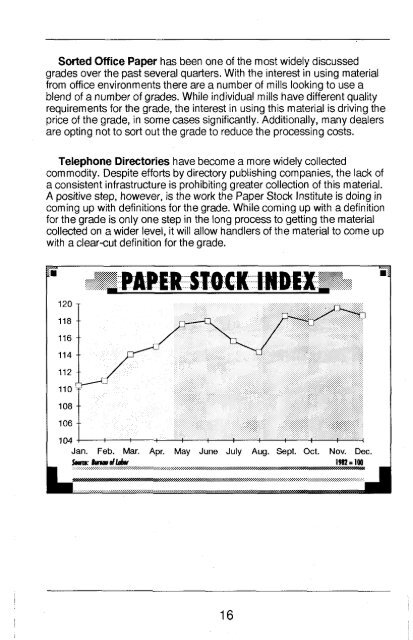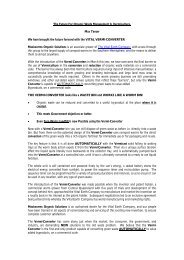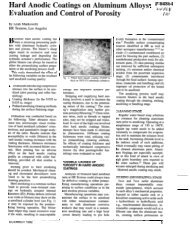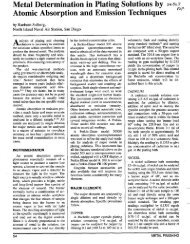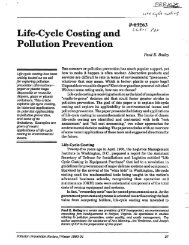- Page 4: Now Available from the Publishers o
- Page 8: TABLE OF CONTENTS Foreword ........
- Page 12: ! FOREWORD The 1993 Paper Recycling
- Page 18: sustainable market, there has to be
- Page 22: NEWSPAPER When discussion turns to
- Page 26: closed plants have added to OCC end
- Page 30: Sorted Office Paper has been one of
- Page 34: Groundwood - Groundwood paper conta
- Page 38: Republic Gypsum, Hutchinson, Kans.
- Page 42: Alabama Joe Piper Inc., 265 Riverch
- Page 46: Alabama Royal St. Junk Co., Inc., P
- Page 50: Arizona Prescoff Beard Recycling, 2
- Page 54: CALIFORNIA Anaheim CVT Recycling, 2
- Page 58: California Bakersfield Baldwin Park
- Page 62: California Burbank Burbank Recycle,
- Page 66:
California Corte Madera Pacific For
- Page 70:
California ReCyCo, Inc., 929 N. Map
- Page 74:
California La Mirada Star Scrap Met
- Page 78:
California Lana Beach Bel-Art Paper
- Page 82:
California Commercial Waste Paper,
- Page 86:
California South Coast Recycling, 4
- Page 90:
California Newark North Hollywood A
- Page 94:
East Coast Operations 324 Newport S
- Page 98:
California Pomona Garden State Pape
- Page 102:
California Riverside Waste Paper Co
- Page 106:
1 I California West Coast Salvage a
- Page 110:
California Waste Management - Great
- Page 114:
California Sun Valley Paper Stock,
- Page 118:
California Weyerhaeuser Paper Compa
- Page 122:
Colorado Rocky Mountain Battery Ser
- Page 126:
Connecticut RRT Empire,211 Murphy R
- Page 130:
Connecticut Woodpulp International,
- Page 134:
Connecticut Wethers field Loretta R
- Page 138:
Florida Clearwater Mac Bay, Inc., 9
- Page 142:
Florida Hollv Hill lnverness Citrus
- Page 146:
Florida Miami A-1 Shredding & Waste
- Page 150:
Florida Recyco of Miami, Inc., 9016
- Page 154:
Florida Recycle America - Orange Co
- Page 158:
Florida Mid South Converting/Sales,
- Page 162:
Florida Venice Venice Scrap Metal,
- Page 166:
Georgia Austell Caraustar Industrie
- Page 170:
Georgia Garden Citw La Grange Bacon
- Page 174:
Georaia Marietta Nahunfa Ralph’s
- Page 178:
Georaia Riceboro Interstate Paper C
- Page 182:
HAWAII Aiea International Metals, I
- Page 186:
Illinois Belleville Belleville Recy
- Page 190:
Illinois Marcells Paper & Metal, In
- Page 194:
Illinois Wolf Mill Supply Co., Inc.
- Page 200:
1 I 1 Illinois Gurnee C.H. Oscarson
- Page 204:
i Illinois Mundelein Alan Josephsen
- Page 208:
I Mansfield, Mass., St. Paul, Mn. I
- Page 212:
Illinois Schaumburg Universal Fiber
- Page 216:
i Indiana Goshen Goshen Iron & Meta
- Page 220:
I 1 I 1 Peru Indiana Plymouth Harry
- Page 224:
i i Iowa Superior Waste Systems, 20
- Page 228:
I I i Kansas Tama Packaging Corpora
- Page 232:
Lexington ~ ~ ~ ~ ~ ~~ ~ ~ Kentuckv
- Page 236:
Jefferson Louisiana Lake Charles Wa
- Page 240:
Sulphur Recycling, 708 East Napoleo
- Page 244:
1 Maine Waste Management of Maine-P
- Page 248:
I i Wrvland Tel. (301) 355-5800. FA
- Page 252:
I Maryland Dorsey Weyerhaeuser Pape
- Page 258:
A ttleboro Waste Management, P.O. B
- Page 262:
Massachusetts East Weymouth Fall Ri
- Page 266:
h&ssachusetts New Bedford A.W. Mart
- Page 270:
Massachusetts Salem Sharon Hanna Pa
- Page 274:
Massachusetts Weston New England Pa
- Page 278:
Michigan International Paper Recycl
- Page 282:
142
- Page 286:
Michiaan Midland Brady Recycling, 3
- Page 290:
Michigans largest Packer of Since 1
- Page 294:
Michigan Wyoming Recycle America of
- Page 298:
Minnesota Pioneer Paper Stock Co.,
- Page 302:
Mississippi Petal Hattiesburg Waste
- Page 306:
I S murfit Recycling Company I "Ame
- Page 310:
Missouri North Kansas City Columbia
- Page 314:
Montana E.J. Keeley Co., Inc., 400
- Page 318:
I New Hammhire Gonic Waste Manageme
- Page 322:
New Jbrsey Bridgeport CRlnc., P.O.
- Page 326:
New Jersey U.S. Pulp & Paper, 1101
- Page 330:
iEk /ZOZZARO BROS, INCS 36 CHESTNUT
- Page 334:
New Arsey John Rocco Scrap Material
- Page 338:
New Jersey Garfield Garden State Pa
- Page 342:
._-__ New .Ic?rsev --.-- Renco Cart
- Page 346:
VPONTE & SONS, INC. Leaders in Sale
- Page 350:
M. Ephraim Gypsum Paper Fiber Corp.
- Page 354:
I New Jersey Ocean Twp. Monmouth Pr
- Page 358:
... NO. 1 IN RECYCLING. . . f '" AW
- Page 362:
New Jersey Rochelle Park Saddle Bro
- Page 366:
New Jersev Vineland Joseph J. Giord
- Page 370:
NEW YORK Albany Ash Trading Corp.,
- Page 374:
New York Peter, Peter, Paper Eater,
- Page 378:
New York Advance Paper Recycling Co
- Page 382:
I i New York Rinaldi Recycling Co.,
- Page 386:
New York Ursula Products, Inc., 636
- Page 390:
New York Colonie (Albany) Yank Wast
- Page 394:
New York Green Island R. Freedman &
- Page 400:
Macedon Alpco Inc., Recycling Div.,
- Page 404:
BROKERS EXPORTERS TEL: (919) 846-88
- Page 408:
I 1 Bulkley Dunton & Co., 271 Madis
- Page 412:
New York Sisco Traders, 150 Nassau
- Page 416:
I New Yo& Recycle Material Inc., Di
- Page 420:
i New York Staten Island Canusa Cor
- Page 424:
“Established 1924 ’’ DEMATTEO
- Page 428:
Harmon Associates World Wide Wastep
- Page 432:
North Carolina $I & W Waste Co., P.
- Page 436:
I North Carolina kMid-South Metals,
- Page 440:
Thomasville North Carolina I ’L&C
- Page 444:
I Ohio Barberlon Maxwell Recycling,
- Page 448:
Ohio BFI - Cleveland Recyclery, 282
- Page 452:
I Ohio Elvria - Elyria Paper & Salv
- Page 456:
I I I Ohio Medina Medina Paper Recy
- Page 460:
Ohio Norfh Lima (Youngsfown) Associ
- Page 464:
i Oklahoma Woosfer Metallics Recycl
- Page 468:
I I Oregon Eugene Eugene Mission In
- Page 472:
With a reputation to be Proud of 4
- Page 476:
i Pennsylvania Bensalem Viking Fibr
- Page 480:
I Pennsylvania Conshohocken Vento,
- Page 484:
I Pennsylvania Automated Recycling
- Page 488:
i 1 Pennsylvania Hollidaysburg Joe
- Page 492:
Pennsylvania Norristo wn A.J. Catag
- Page 496:
I Pennsylvania Chas. Piacentino Inc
- Page 500:
Primos NU-Way Trash Removal, P.O. B
- Page 504:
Pennsylvania Waste Management of In
- Page 508:
I ~ Pawtucket Berger 8, Company, 12
- Page 512:
NOT ONE BUT. . . 22 Paper Stock Pro
- Page 516:
Southern Paper Stock Co. your best
- Page 520:
i Tennessee Chattanooga BFI of Tenn
- Page 524:
I Tennessee Ira Levy & Assoc.,P.O.
- Page 528:
I Texas Carrollton Weyerhaeuser Rec
- Page 532:
1 Texas Fort Worth Document Destruc
- Page 536:
Texas Vista Fibers, Div. of Allied
- Page 540:
I I Vennont UTAH Murray Interwest P
- Page 544:
Virginia Chesapeake Tidewater Fibre
- Page 548:
I Vig jnia Richmond Commodity Recyc
- Page 552:
West Coast Operations 41 22 East Ch
- Page 556:
I ! Washington Kirkand Pacific Coas
- Page 560:
Washington Rabanco Recycling, 2733
- Page 564:
~ 1 i Wisconsin Keyser Quality Supp
- Page 568:
I Wisconsin Western Wisconsin Recyc
- Page 572:
I i Wisconsin Waste Management of M
- Page 576:
Wisconsin Standard Scrap Metal Ltd.
- Page 580:
1 Edmonton British Columbia BFI, Lt
- Page 584:
CANADA. NOVA SCOTIA New Mines Josep
- Page 588:
I Ontario Concord BFI, Ltd., 550 Bo
- Page 592:
1 Ontario CRlnc., 400 Commissioners
- Page 596:
Completely automatic press for new
- Page 600:
Quebec Portneuf J. Ford & Co., Ltd.
- Page 604:
i ENGLAND France Abingdon, Oxon Sou
- Page 608:
j Ifa/y Industrial Metallics, Rusto
- Page 612:
i Puerto Rico Mexico, D. F. Pronapa
- Page 616:
United Arab Emirates AI Khobar Mare
- Page 620:
! I ALABAMA Albertville Keyes Fibre
- Page 624:
ARIZONA Arkansas Flagstaff Orchids
- Page 628:
California La Palma Orchid Paper Pr
- Page 632:
I i Connecticut Lunday-Thagard Roof
- Page 636:
Hialeah Atlas Tissue Mills, 3725 E.
- Page 640:
Georaia " Brunswick . Brunswick Pul
- Page 644:
Alton Illinois Aurora Aurora Paperb
- Page 648:
I Indiana Eaton Rock-Tenn Co., Rout
- Page 652:
I KENTUCKY Louisiana Ha wes wile Wi
- Page 656:
Maine Lincoln Lincoln Pulp & Paper
- Page 660:
Massachusetts Boston Patriot Paper
- Page 664:
Michigan South Hadley Decorative-Sp
- Page 668:
i Monroe Michiaan Monroe Paper Co.,
- Page 672:
I MINNESOTA Mississippi Grand Rapid
- Page 676:
Berlin James River Corp., 650 Main
- Page 680:
New Jersey Garwood Garwood Paperboa
- Page 684:
New York James River Corp., 695 Wes
- Page 688:
I New York Mechanicville Tagsons Pa
- Page 692:
NORTH CAROLINA Canton LChampion Int
- Page 696:
I Ohio PM Company, 24 Triangle Park
- Page 700:
OMahoma Toronto Valley Converting C
- Page 704:
I Pennsylvania Pilot Rock Wood Fibe
- Page 708:
Pennsylvania Lock Haven Internation
- Page 712:
SOUTH CAROLINA Tennessee Beech Isla
- Page 716:
I Texas Ponderosa Fibres, 1531 N. T
- Page 720:
VERMONT Vitginia Bra ff Ieboro Spec
- Page 724:
WASHINGTON Washington Bellingham Ge
- Page 728:
I 1 WISCONSIN Wisconsin Appleton Fo
- Page 732:
I Wisconsin Geo. A. Whiting Paper C
- Page 736:
We’ve got the rail system for you
- Page 740:
i NEW BRUNSWICK Bathurst Consolidat
- Page 744:
Quebec Noranda Forest Recycled Pape
- Page 748:
i Quebec Mwog Orford Recycling, Inc
- Page 752:
American Newspaper Publishers Assoc
- Page 756:
Paper Stock Institute of America, 1
- Page 760:
ALASKA State Dept. of Environmental
- Page 764:
California Municipality Berkeley De
- Page 768:
I California Pasadena City of Pasad
- Page 772:
District of Columbia State Departme
- Page 776:
I Georgia Fort Myers City of Ft. My
- Page 780:
! Illinois Municipality Boise City
- Page 784:
I 1 8 I Kansas South Bend Solid Was
- Page 788:
Municipality Lafayeite Environmenta
- Page 792:
i Michigan Department of Environmen
- Page 796:
I Mississippi Office of Waste Manag
- Page 800:
New Hampshire Solid and Hazardous W
- Page 804:
New Jersev Union Utilities Authorit
- Page 808:
New Yo& County Erie Dept. of Public
- Page 812:
1 NORTH DAKOTA State North Dakota R
- Page 816:
I Pennsylvania Municipality Eugene
- Page 820:
I SOUTH CAROLINA South Dakota State
- Page 824:
I Vermont Houston City of Houston,
- Page 828:
i Washington Roanoke Roanoke City P
- Page 832:
I Wyoming County Milwaukee Milwauke
- Page 836:
A.6. Consolidated Waste Management,
- Page 840:
i Allegheny Paper Shredders Corpora
- Page 844:
Balemaster, 980 Crown Court, Crown
- Page 848:
Buckhorn Canada, Inc., 2775 Slouch
- Page 852:
Chem-tainer Industries, 361 Neptune
- Page 856:
Compac Specialties, Inc., 136 E. 6t
- Page 860:
Eidal Shredders, P.O. Box 529, West
- Page 864:
433 ning Introducing EPCO'S EX-72r
- Page 868:
Global Strapping Systems, Inc., 103
- Page 872:
i @ Office Paper Recycling System @
- Page 876:
K-PAC Division of Krause Corporatio
- Page 880:
Lummus Development Corp., P. 0. Box
- Page 884:
Mij. Bronneberg Helmond B.V., Haags
- Page 888:
P ul Combimng unmatched product thr
- Page 892:
“For your WASTE MANAGEMENT needs
- Page 896:
i Safco Diversified Recycling Syste
- Page 900:
Thomas P. Stevens, Inc., 2569 Dixie
- Page 904:
NATIONAL DISTRIBUTORS 3M, Commercia
- Page 908:
CONSULTANTS Robert V. Adelman, Cons
- Page 912:
Manifold Colored Ledger(39) Sorted
- Page 916:
2150 Sales Corp ...................
- Page 920:
BFI of Florda . Inc ...............
- Page 924:
I Dean wiping Cloth Corp ..........
- Page 928:
Howard Zuker Associates .. .98 Hub
- Page 932:
Michael Ruzzo Industries Inc ......
- Page 936:
Pontiac Recvclers. Inc. ...........
- Page 940:
Smurfit Recycling .. ..............
- Page 944:
Waste Management of Houston . 269 W
- Page 948:
ADVERTISER INDEX ABC Baling Wire Su
- Page 952:
ADVERTISER INDEX Mosley Machinery C
- Page 956:
6LP S3lON
- Page 960:
18P S310N


